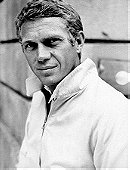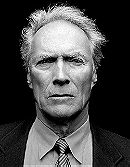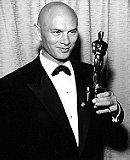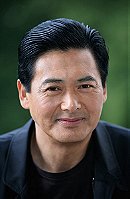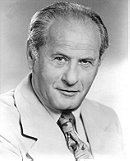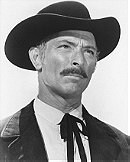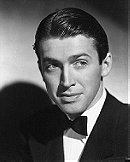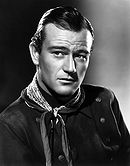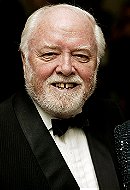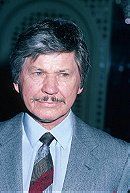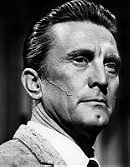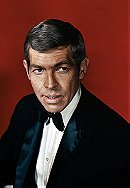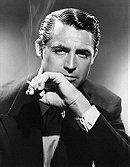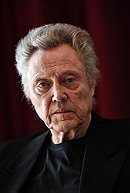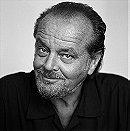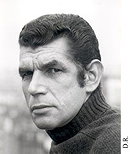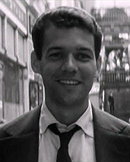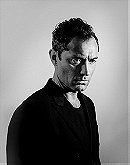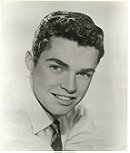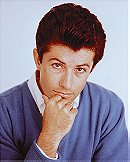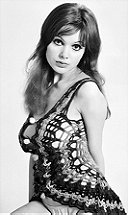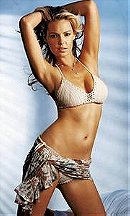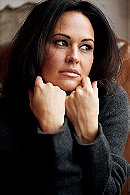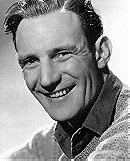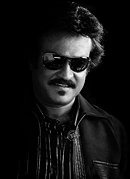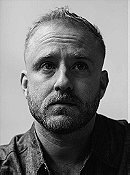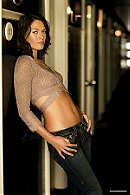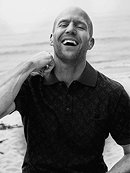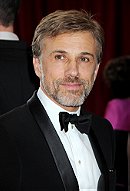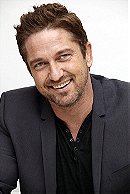Favorite Actors & Actresses
Sort by:
Showing 45 items
Rating:
List Type:
Paul Newman Biography
In a business where public scandal and bad-boy behavior are the rule rather than the exception, Paul Newman is as much a hero offscreen as on. A blue-eyed matinee idol whose career successfully spanned five decades, he was also a prominent social activist, a major proponent of actors' creative rights, and a noted philanthropist. Born January 26, 1925, in Cleveland, OH, Newman served in World War II prior to attending Kenyon College on an athletic scholarship; when an injury ended his sports career, he turned to drama, joining a summer stock company in Wisconsin. After relocating to Illinois in 1947, he married actress Jacqueline Witte, and, following the death of his father, took over the family's sporting-goods store. Newman quickly grew restless, however, and after selling his interest in the store to his brother, he enrolled at the Yale School of Drama. During a break from classes he traveled to New York City where he won a role in the CBS television series The Aldrich Family. A number of other TV performances followed, and in 1952 Newman was accepted by the Actors' Studio, making his Broadway debut a year later in Picnic, where he was spotted by Warner Bros. executives.Upon Newman's arrival in Hollywood, media buzz tagged him as "the new Brando." However, after making his screen debut in the disastrous epic The Silver Chalice, he became the victim of scathing reviews, although Warners added on another two years to his contract after he returned to Broadway to star in The Desperate Hours. Back in Hollywood, he starred in The Rack. Again reviews were poor, and the picture was quickly pulled from circulation. Newman's third film, the charming Somebody Up There Likes Me, in which he portrayed boxer Rocky Graziano, was both a commercial and critical success, with rave reviews for his performance. His next film of note was 1958's The Long Hot Summer, an acclaimed adaptation of a pair of William Faulkner short stories; among his co-stars was Joanne Woodward, who soon became his second wife. After next appearing as Billy the Kid in Arthur Penn's underrated The Left-Handed Gun, Newman starred opposite Elizabeth Taylor in Cat on a Hot Tin Roof, scoring his first true box-office smash as well as his first Academy Award nomination.After appearing with Joanne Woodward in Rally 'Round the Flag, Boys! -- the couple would frequently team onscreen throughout their careers -- Newman traveled back to Broadway to star in Tennessee Williams' Sweet Bird of Youth. Upon his return to the West Coast, he bought himself out of his Warner Bros. contract before starring in the 1960 smash From the Terrace. Exodus, another major hit, quickly followed. While by now a major star, the true depths of Newman's acting abilities had yet to be fully explored; that all changed with Robert Rossen's 1961 classic The Hustler, in which he essayed one of his most memorable performances as pool shark "Fast" Eddie Felson, gaining a second Oscar nomination. His third nod came for 1963's Hud, which cast him as an amoral Texas rancher. While a handful of creative and financial disappointments followed, including 1964's The Outrage and 1965's Lady L, 1966's Alfred Hitchcock-helmed Torn Curtain marked a return to form, as did the thriller Harper.For 1967's superb chain-gang drama Cool Hand Luke, Newman scored a fourth Academy Award nomination, but again went home empty-handed. The following year he made his directorial debut with the Joanne Woodward vehicle Rachel Rachel, scoring Best Director honors from the New York critics as well as an Oscar nomination for Best Picture. The couple next appeared onscreen together in 1969's Winning, which cast Newman as a professional auto racer; motor sports remained a preoccupation in his real life as well, and he was the most prominent of the many celebrities who began racing as a hobby. He then starred with Robert Redford in 1969's Butch Cassidy and the Sundance Kid, which went on to become the highest-grossing Western in movie history. It was followed by 1971's W.U.S.A., a deeply political film reflecting Newman's strong commitment to social activism; in addition to being among Hollywood's most vocal supporters of the civil rights movement, in 1968 he and Woodward made headlines by campaigning full time for Democratic Presidential candidate Eugene McCarthy.After directing and starring in 1971's Sometimes a Great Notion, Newman announced the formation of First Artists, a production company co-founded by Barbra Streisand and Steve McQueen. Modeled after the success of United Artists, it was created to offer performers the opportunity to produce their own projects. Newman's first film for First Artists' was 1972's Pocket Money, followed by another directorial effort, The Effect of Gamma Rays on Man-in-the-Moon Marigolds. After a pair of back-to-back efforts under director John Huston, 1972's The Life and Times of Judge Roy Bean and the next year's The Mackintosh Man, Newman reunited with Redford in The Sting, another triumph which won the 1973 Best Picture Oscar. He next appeared in the star-studded disaster epic The Towering Inferno, followed by 1975's The Drowning Pool, a sequel to Harper. His next major success was the 1977 sports spoof Slap Shot, which went on to become a cult classic.A string of disappointments followed, including Robert Altman's self-indulgent 1979 effort Quintet. The 1981 Absence of Malice, however, was a success, and for 1982's courtroom drama The Verdict Newman notched his fifth Best Actor nomination. He finally won the Oscar on his sixth attempt, reprising the role of Eddie Felson in 1986's The Color of Money, Martin Scorsese's sequel to The Hustler. After starring in two 1989 films, Blaze and Fat Man and Little Boy, Newman began appearing onscreen less and less. In 1991, he and Joanne Woodward starred as the titular Mr. and Mrs. Bridge, and three years later he earned yet another Academy Award nomination for his superb performance in Robert Benton's slice-of-life tale Nobody's Fool. His films since then have been fairly sparse and of mixed quality, with Joel Coen's and Ethan Coen's The Hudsucker Proxy (1994) being at the higher end of the spectrum and the Kevin Costner vehicle Message in a Bottle (1999) resting near the bottom. Newman again graced screens in 2000 with Where the Money Is, a comedy that cast him as a famous bank robber who fakes a stroke to get out of prison. For his role as a kindly crime boss in 2002's Road to Perdition, Newman became a ten-time Oscar nominee.Turning 80 in 2005, Newman nonetheless remained a presence in Hollywood. That year, audiences could see him on the small-screen in the critically-acclaimed HBO miniseries Empire Falls, for which he won a Golden Globe, and the following year, he lent his voice to the Pixar animated film Cars.Despite his movement away from Hollywood, Newman remained a prominent public figure through his extensive charitable work; he created the Scott Newman Foundation after the drug-related death of his son and later marketed a series of gourmet foodstuffs under the umbrella name Newman's Own, with all profits going to support his project for children suffering from cancer. Newman died on September 26, 2008 after a battle with lung cancer.
bharath's rating:


Steve McQueen Biography
Steve McQueen (March 24, 1930 ?? November 7, 1980) was an American movie actor, nicknamed "The King of Cool". He was considered one of the biggest box-office draws of the 1960s and 1970s due to a captivating on-screen persona. McQueen was considered combative and the archetypal "difficult movie star" who disliked working with directors and producers. To compensate, he would work only if paid an extremely large salary for his films; he was one of the highest paid actors of the 1960s and 1970s. Early life
He was born Terence Steven McQueen in Beech Grove, Indiana. He never knew his father (who abandoned his wife and child shortly after McQueen was born) - although he did find the house where he lived approximately a year after his father's death.
His mother left him at an early age and he was raised in Slater, Missouri by his uncle. At the age of 12 he was reunited with his mother and went to live in Los Angeles, California. However by the time he was 14 she had sent him to the Boys Republic home for wayward boys in Chino Hills, California.
After McQueen left Chino, he drifted before joining the United States Marine Corps in 1947 and served until 1950. In 1952, with financial assistance of the G.I. Bill, McQueen began studying acting and auditioned to study at Lee Strasberg's Actors' Studio in New York. Of the 2000 people who auditioned that year, only McQueen and Martin Landau were accepted. McQueen made his Broadway debut in 1955 in A Hatful of Rain. Key appearances Wanted: Dead or Alive
After various live and filmed television guest appearances in the mid-1950s, McQueen gained both regular employment and his 'break-out' role with the Western series Wanted: Dead or Alive. From 1958 to 1961, McQueen played Josh Randall, a lone bounty hunter whose weapon of choice was a sawed-off Winchester repeating rifle nicknamed the 'Mare's Leg.' While the character of Randall traveled the Wild West helping various people he met, it was the anti-hero image of a bounty-hunter, played with precisely the right amount of mystery, alienation and detachment by McQueen, that made this show stand out from among the large group of typical Westerns on American TV at the time. The character had been introduced the previous year in an episode of Trackdown, another western TV series, featuring Robert Culp. The Magnificent Seven
McQueen moved into film in the mid-1950s with bit parts in Girl on the Run (1953) and Somebody Up There Likes Me (1956). He secured his first lead role in the 1958 horror movie The Blob. He then replaced Sammy Davis, Jr. in the Frank Sinatra vehicle Never So Few in 1959 when Sinatra quarrelled with Davis. The director, John Sturges, then cast McQueen in his next movie, promising to "give him the camera". Starring with Yul Brynner, Robert Vaughn, Charles Bronson, and James Coburn in The Magnificent Seven (1960), it would be McQueen's first major hit. The Great Escape
McQueen's next big film was 1963's The Great Escape (which also starred Bronson and Coburn, as well as second-billed James Garner). The smash hit movie told the more or less true story of a massive breakout from a World War II POW camp and McQueen has a memorable role in the climax of the film, highlighted by a spectacular motorcycle leap. McQueen's friend and fellow cycle enthusiast Bud Ekins, who resembled McQueen from a distance, actually made the jump, but the general public did not know that for years. Bullitt and later films
Another successful film came in 1968 with Bullitt, which thrilled audiences with an unprecedented (and endlessly imitated) auto chase through San Francisco, with Bud Ekins again doubling for some of the more hazardous work. Prior to that, he earned his only Academy Award nomination for the 1966 film The Sand Pebbles. McQueen also appeared in 1973's Papillon, the 1971 car race drama Le Mans, and in The Getaway in 1972.
McQueen was the world's highest paid actor by the time of The Getaway. After The Towering Inferno, co-starring with his long time friend and rival Paul Newman in 1974, McQueen did not return to film until 1978 with An Enemy of the People playing against type as an overweight, heavily bearded character, in this adaptation of the Henrik Ibsen play. The film was little seen and has never been released on Video or DVD, but is aired from time to time on PBS. Marriages
McQueen married actress Neile Adams on November 2, 1956 (divorced 1972), by whom he had a daughter Terry (born June 5, 1959; died at 38 on March 19, 1998 as a result of hemochromatosis, a condition in which the body produces too much iron destroying the liver), and a son, Chad (born December 28, 1960 and now an actor - as is his son, Steven R. McQueen, born 1988).
On August 31, 1973 he married his Getaway co-star, Ali MacGraw, with whom he had a passionate but tumultuous relationship (she left her husband, film producer Robert Evans for McQueen). They were divorced in 1978.
His third wife was model Barbara Minty whom he married on January 16, 1980, less than a year before his death. Arrest
In 1972 McQueen was arrested in Anchorage, Alaska, for driving under the influence of alcohol and skipped bail.joblo.com - The Ten Spot 2/2
Motor Racer
McQueen was an avid motorcycle and racecar enthusiast. When he had the opportunity to drive in a movie, he often did so himself, performing many of his own stunts.
The most memorable were the classic chase in Bullitt and the motorcycle chase scene in The Great Escape. The jump over the fence was actually done by Bud Ekins for insurance purposes. (However, McQueen did have a considerable amount of screen time while riding his motorcycle. According to the commentary track on the Great Escape DVD, it was difficult to find riders as skilled as McQueen and at one point in the film, due to clever editing, McQueen is seen in a German uniform and chasing himself on another bike).
During his acting career he considered becoming a professional race car driver. In the 1970 race 12 Hours of Sebring, Peter Revson and McQueen (driving with a cast on his left foot from a motorcycle accident two weeks before) won in their (engine size) class and missed winning overall by a scant 23 seconds to Mario Andretti in a Ferrari with a Porsche 908/02. The same car was used as a camera car for Le Mans in the 24 Hours of Le Mans later that year, entered by his production company Solar Productions. However, the film was a box office flop that almost ruined McQueen's career and McQueen himself admitted that he almost died while filming the movie.
McQueen himself wanted to enter a Porsche 917 together with Jackie Stewart in the 1970 Le Mans race but the backers for his film project threatened to pull their support if he drove in the race. Faced with driving for 24 hours in the race, or the entire summer making the film, McQueen opted to do the latter.
He also competed in off-road motorcycle racing. McQueen raced in many of the top off-road races on the West Coast during the ??60s and early-1970s, including the Baja 1000, the Mint 400 and the Elsinore Grand Prix. In 1964, he represented the United States in the International Six Days Trial, a form of off-road motorcycling Olympics. He was inducted in the Off-road Motorsports Hall of Fame in 1976. In 1971, Solar Productions funded the now-classic motorcycle documentary On Any Sunday, in which McQueen himself is featured, along with racing legends Mert Lawwill and Malcolm Smith.
In a segment filmed for The Ed Sullivan Show, McQueen drove Sullivan around a desert area in a dune buggy at high speed. At the end of the trip, all the breathless Sullivan could say was, "That was a helluva ride!"
He owned several luxurious and exotic sportscars, including: Porsche 917, Porsche 908 and Ferrari 512 race cars from the Le Mans film. Ferrari 250 Lusso Berlinetta Jaguar D-Type XKSS Porsche 356 Speedster
To his dismay, McQueen was never able to own the legendary Ford Mustang GT that he drove in Bullitt. There were two cars used for filming. It is rumored that both models of the car mysteriously disappeared after the film wrapped (similar to the Easy Rider bikes).
The film's director Peter Yates recently stated in a radio interview that both vehicles are still extant (BBC Radio 4, 7 January 2006) (see [1]). Death
McQueen died at the age of 50, on November 7, 1980, in Jurez, Mexico of a heart attack following cancer surgery. McQueen had traveled to the Santa Rosa Clinic in Mexico for alternative treatments for mesothelioma, a rare form of lung cancer caused by asbestos exposure. It is unclear whether the asbestos exposure came from his racing career or from an experience in the United States Marine Corps; he wore an asbestos-insulated racers suit in his race cars and when working on his own cars and motorbikes would use an asbestos soaked rag to cover his mouth from other fumes, and McQueen himself admitted that he was exposed to the deadly insulating material during his stint in the Marines.
Controversy arose over his Mexican trip, because McQueen sought a very non-traditional treatment that used coffee enemas and laetrile, a supposedly "natural" anti-cancer drug available in Mexico but not approved by the U.S. Food and Drug Administration. In any event, the cancer was too far advanced for any treatment to have been effective.
In 1999, McQueen was posthumously inducted into the Motorcycle Hall of Fame. Personal information
McQueen's height was approximately 5'9". He had a daily two-hour exercise regime, involving weightlifting and at one point running five miles, seven days a week. However, he was also known for his prolific drug use (William Caxton claimed he smoked marijuana almost every day; others said he used a tremendous amount of cocaine). In addition, like most actors of his era, he was a smoker.
After Charles Manson incited the murder of five people including McQueen's close personal friends Sharon Tate and Jay Sebring at Tate's home on August 9, 1969, it was reported the MacQueen was another potential target of the killers. He began carrying a gun on him, including when he attended Sebring's funeral Dunne, Dominick. The Way We Lived Then: Recollections of a Well Known Name Dropper. 1999. Crown Publishers. ISBN 0-609-60388-4.
.
McQueen had a reputation for demanding free items from studios when agreeing to do a film, such as electric razors, jeans and several other products. It was later found out that McQueen requested these items because he was donating them to the Boy's Republic reformatory school for displaced youth, where McQueen spent time during his youth. McQueen was later said to have made occasional visits to the school to spend time with the students and play pool with them.
McQueen learnt the martial art Tang Soo Do from ninth degree blackbelt Pat E. Johnson, and served as one of the pall bearers at Bruce Lee's funeral in 1973. Chuck Norris taught McQueen's son karate, while Lee trained him in Jeet Kune Do. Later on, McQueen convinced Norris to attend acting classes.
His name somehow ended up on President Richard Nixon's infamous Enemies List. This may be due to the fact that he had an "outlaw, rebellious" on screen image. Ironically, in real life, McQueen was quite conservative in his political views, and quite often backed the Republican party. He supported the war in Vietnam, was one of the few Hollywood stars who refused numerous requests to back Presidential hopeful Robert Kennedy in 1968, and turned down the chance to participate in the 1963 March for Civil Rights on Washington. When McQueen heard he had been added to Nixon's Enemies List, he responded by immediately flying a giant American flag outside his house. Reportedly, his wife Ali McGraw responded to the whole affair by saying "But you're the most patriotic person I know." Missed roles
McQueen was offered the lead role in Breakfast at Tiffany's but was unable to accept due to his Wanted: Dead or Alive contract. The role went to George Peppard. He also turned down Ocean's Eleven, Butch Cassidy and the Sundance Kid, The Driver, Apocalypse Now, and Dirty Harry. He had been interested in starring in First Blood, but could not due to his illness/death. He had also been offered the Kevin Costner role in The Bodyguard when it was first proposed in 1976.
McQueen was also interested in making the film version of Waiting for Godot. During his time away from film he developed an interest in the classic playwrights. This led him to Beckett's Godot, but the playwright had never heard of Steve McQueen. Hobbies Patented a specific bucket seat in a racecar. The First Steve McQueen Site - FAQ/Trivia Was to co-drive in a Triumph 2500 PI for the British Leyland team in the 1970 London-Mexico rally, but had to turn it down due to movie commitments. High prices for memorabilia
The tinted sunglasses worn by McQueen in the 1968 movie The Thomas Crown Affair sold at a Los Angleles auction for $70,200 in 2006. [2] One of his motorcycles, a 1937 Croker, sold for a world record price of $276,500 at the same auction. Pop culture mentions He is mentioned as Bart Simpson's hero by Homer in The Simpsons episode "Saturdays of Thunder". Though Marge corrects Homer by saying "That's your hero". McQueen appeared in a commercial for the 2005 Ford Mustang which used scenes from Bullitt, and showed McQueen racing the new car around a race track built in a corn field, la baseball field in Field of Dreams. An earlier (circa 1997) advert, for the Ford Puma used a similar technique by splicing the Puma (with McQueen driving) into scenes from Bullitt all to the popular theme tune from that film. McQueen also posthumously appeared in another ad for beer in the UK. Scenes from The Great Escape were used in this commercial.
He was mentioned in various songs and quotes as well: During their performance of Highway Star in 1972 on Beat Club, Deep Purple's Ian Gillan ad libs a lyric of Like Steve McQueen, Mickey Mouse and all that lot. Prefab Sprout released an album entitled Steve McQueen in 1985. McQueen was the subject of the 2002 Sheryl Crow song called "Steve McQueen" off the album C'mon C'mon ?? the video has her riding a motorcycle like in "The Great Escape", driving a Ford GT40 at Willow Springs Raceway to simulate Le Mans, and being chased by NASCAR driver Dale Earnhardt Jr in a Bullitt Mustang. Including the lyrics "Just like Steve McQueen all I need is a fast machine". The Harpo song "Moviestar" starts with the lyrics "You feel like Steve McQueen when you're driving in your car". The MF DOOM song Kon Queso: "Seen 'em on the big screen like Steve McQueen, do something and never be back once he leave the scene." The comedy duo of Richard "Cheech" Marin and Tommy Chong (aka "Cheech & Chong") in a skit entitled "The Continuing Adventures of Pedro and Man" (on the album Cheech and Chong's Greatest Hit), "Man" (Chong) says Pedro (Marin) drives, "Just like Steve McQueen", meaning he is driving well. Rock group Clutch claims "Steve McQueen's got nothing on me" in their song "The House that Peterbilt." Along with Martin Sheen and James Dean, he is mentioned in the R.E.M. song "Electrolite". In the song "Gene by Gene" by Blur, on their album Think Tank, the narrator claims to "...ride a Bullitt like Steve McQueen," presumably a reference to Bullitt, in which he starred. Beastie Boys mention McQueen in their song "High Plains Drifter", "I feel like Steve McQueen, a former movie star". In the 1996 film Beautiful Girls, Willie's girlfriend comments about how his father and brother took a liking to her upon their first meeting, which Willie remarks "They haven't felt this strongly about anyone since Steve McQueen died". In the Divine Comedy song "Absent Friends", Neil Hannon sings: "Steve McQueen jumped the first one clean/ But the great escape/ He tried to make/ Was not to be/ Maybe next time, Steve". Steve McQueen figures heavily in the 2000 film The Tao of Steve. The soundtrack includes a song titled "(I Just Wanna Be) Your Steve McQueen" by singer/songwriter Eytan Mirsky (who has also contributed original songs to the soundtracks of the indie films "Happiness," "American Splendor," and "Palindromes," among others). In his song "Beautiful Life", Shy Nobleman sings "Greet the neighbor, Steve McQueen". A large section of the film Heat was closely based on the ending of McQueen's biggest hit, Bullitt. Drive-By Truckers have a song called "Steve McQueen" on their 1998 album "Gangstabilly" (re-released in 2005). In an episode of Arrested Development a reference to McQueen is used when Lucille says to Buster, "...and now you think you're Steve McQueen" referencing to Buster's first date. The Sweetwater track Cake & Strychnine, from their release Superfriends, opens with the line "Slit yourself with a plastic razor / Cool, like Steve McQueen." The Supergrass track Prophet 15, from their 2002 release of Life on Other Planets, features the line "Che Guevara and Steve McQueen, right there, Oh Yeah". On the album Goats Head Soup by The Rolling Stones, McQueen is mentioned in the final song, "Star Star": "Yeah, Ali McGraw got mad at you / For givin' head to Steve McQueen". In the Lupin III episode "I Left My Mind in San Francisco", there is a scene where Jigen, Lupin, and Goemon are chasing Zenigata through San Francisco (in very similar fashion to Bullitt). After narrowly missing hitting a truck in an alleyway by making the car go on 2 wheels, Jigen says, "Sorry, I must have been possessed by the spirit of Steve McQueen". In the Feeder song "Under The Weather" off the 2001 album "Echo Park", McQueen's name is mentioned ("I wish that I was still fifteen, Debbie Harry and Steve McQueen"). Lambchop have a song called Steve McQueen on the album "Aw C'mon". The Gomez song "78 Stone Wobble" contains a spoken word sample, which ends with the words "Sean Connery or Steve McQueen" being looped. Elton John and Bernie Taupin mention him in the song "Postcards From Richard Nixon",on the album "Captain and the Kid" ("In a bright red Porsche on Sunset I saw Steve McQueen, I guess he's just about the coolest guy I've ever seen") The song 'Promiscuous' by Nelly Furtado featuring Timbaland contains the lyrics 'They call me Thomas, last name Crown, recognize game, I'm a lay mine's down.' Thomas Crown was Steve's character in 'The Thomas Crown Affair' The South Australian band The Audreys have a song titled "You & Steve McQueen". Legendary New England DJ/Entertainer Russ McQueen chose his stage name as an homage to Steve McQueen. In House, the pet rat of Dr. Gregory House (Hugh Laurie) is named "Steve McQueen". The movie The Tao of Steve starring Donal Logue is about a group of middle-aged men who combine the ideas of famous intellectuals to create a foolproof theory of "dating" - The Tao of Steve. Their idol in the movie is Steve McQueen who represents the essence of cool. Frequently cited the "All Guts No Glory" Detective Frank Bullitt as his favorite character he ever played. In Disney and Pixar's film Cars', the main character, Lightning McQueen, is named after Steve and former Pixar animator Glenn McQueen. McQueen is frequenly mentioned during discussions between characters Deaq & Van in the TV show Fastlane Filmography Girl on the Run (1953) Somebody Up There Likes Me (1956) Never Love a Stranger (1958) The Blob (1958) The Great St. Louis Bank Robbery (1959) Never So Few (1959) The Magnificent Seven (1960) The Honeymoon Machine (1961) Hell Is for Heroes (1962) The War Lover (1962) The Great Escape (1963) Soldier in the Rain (1963) Love with the Proper Stranger (1963) Baby the Rain Must Fall (1965) The Cincinnati Kid (1965) Nevada Smith (1966) The Sand Pebbles (1966) - ACADEMY AWARD NOMINATION for Best Actor in a Leading Role Think Twentieth (1967) (short subject) Bullitt: Steve McQueen's Commitment to Reality (1968) (short subject) The Thomas Crown Affair (1968) Bullitt (1968) The Reivers (1969) Le Mans (1971) On Any Sunday (1971) (documentary) Junior Bonner (1972) The Getaway (1972) The Life and Legend of Bruce Lee (1973) (documentary) Papillon (1973) The Towering Inferno (1974) Dixie Dynamite (1976) (Cameo) Bruce Lee, the Legend (1977) (documentary) An Enemy of the People (1978) (also executive producer) Tom Horn (1980) (also executive producer) The Hunter (1980)
bharath's rating:


Clint Eastwood Biography
With his rugged good looks and icon status, Clint Eastwood was long one of the few actors whose name on a movie marquee could guarantee a hit. Less well-known for a long time (at least until he won the Academy Award as Best Director for Unforgiven), was the fact that Eastwood was also a producer/director, with an enviable record of successes. Born May 31, 1930, in San Francisco, Eastwood worked as a logger and gas-station attendant, among other things, before coming to Hollywood in the mid-'50s. After his arrival, he played small roles in several Universal features (he's the pilot of the plane that napalms the giant spider at the end of Tarantula [1955]) before achieving some limited star status on the television series Rawhide. Thanks to the success of three Italian-made Sergio Leone Westerns -- A Fistful of Dollars (1964), For a Few Dollars More (1965), and The Good, the Bad and the Ugly (1966) -- Eastwood soon exchanged this limited status for bona fide international stardom.Upon his return to the U.S., Eastwood set up his own production company, Malpaso, which had a hit right out of the box with the revenge Western Hang 'Em High (1968). He expanded his relatively limited acting range in a succession of roles -- most notably with the hit Dirty Harry (1971) -- during the late '60s and early '70s, and directed several of his most popular movies, including 1971's Play Misty for Me (a forerunner to Fatal Attraction), High Plains Drifter (1973, which took as its inspiration the tragic NYC murder of Kitty Genovese), and The Outlaw Josey Wales (1976). Though Eastwood became known for his violent roles, the gentler side of his persona came through in pictures such as Bronco Billy (1980), a romantic comedy that he directed and starred in. As a filmmaker, Eastwood learned his lessons from the best of his previous directors, Don Siegel and Sergio Leone, who knew just when to add some stylistic or visual flourish to an otherwise straightforward scene, and also understood the effect of small nuances on the big screen. Their approaches perfectly suited Eastwood's restrained acting style, and he integrated them into his filmmaking technique with startling results, culminating in 1993 with his Best Director Oscar for Unforgiven (1992). Also in 1993, Eastwood had another hit on his hands with In the Line of Fire. In 1995, he scored yet again with his film adaptation of the best-selling novel The Bridges of Madison County, in which he starred opposite Meryl Streep; in addition to serving as one of the film's stars, he also acted as its director and producer.Aside from producing the critical and financial misstep The Stars Fell on Henrietta in 1995, Eastwood has proven to be largely successful in his subsequent efforts. In 1997, he produced and directed the film adaptation of John Berendt's tale of Southern murder and mayhem, Midnight in the Garden of Good and Evil, and he followed that as the director, producer, and star of the same year's Absolute Power, 1999's True Crime, and 2000's Space Cowboys. With Eastwood's next movie, Blood Work (2002), many fans pondered whether the longtime actor/director still had what it took to craft a compelling film. Though some saw the mystery thriller as a fair notch in Eastwood's belt, many complained that the film was simply too routine, and the elegiac movie quickly faded at the box office. If any had voiced doubt as to Eastwood's abilities as a filmmaker in the wake of Blood Work, they were in for quite a surprise when his adaptation of the popular novel Mystic River hit screens in late 2003. Featuring a stellar cast that included Sean Penn, Tim Robbins, and Kevin Bacon, Mystic River was a film that many critics and audiences cited as one of the director's finest. A downbeat meditation on violence and the nature of revenge, the film benefited not only from Eastwood's assured eye as a director, but also from a screenplay (by Brian Helgeland) that remained fairly faithful to Dennis Lehane's novel and from severely affecting performances by its three stars -- two of whom (Penn and Robbins) took home Oscars for their efforts. With Eastwood's reputation as a quality director now cemented well in place thanks to Mystic River's success, his remarkable ability to craft a compelling film was nearly beginning to eclipse his legendary status as an actor in the eyes of many. Indeed, few modern directors could exercise the efficiency and restraint that have highlighted Eastwood's career behind the camera, as so beautifully demonstrated in his 2004 follow-up, Million Dollar Baby. It would have been easy to layer the affecting tale of a young female boxer's rise from obscurity with the kind of pseudo-sentimental slop that seems to define such underdog-themed films, but it was precisely his refusal to do so that ultimately found the film taking home four of the six Oscars for which it was nominated at the 77th Annual Academy Awards -- including Best Director and Best Picture. Eastwood subsequently helmed two interrelated 2006 features that told the story of the Battle of Iwo Jima from different angles. The English-language Flags of Our Fathers relayed the incident from the American end, while the Japanese-language Letters from Iwo Jima conveyed the event from a Japanese angle. Both films opened to strong reviews and were lauded with numerous critics and industry awards, with Letters capturing the Golden Globe for Best Foreign Language film before being nominated for a Best Picture Academy Award. Nowhere near slowing down, Eastwood would direct and star in the critically acclaimed Gran Torino, as well as helming critical favorites like Invictus, the Changeling, Hereafter, and J. Edgar, racking up numerous awards and nominations.A prolific jazz pianist who occasionally shows up to play piano at his Carmel, CA restaurant, The Hog's Breath Inn, Eastwood has also contributed songs and scores to several of his films, including The Bridges of Madison County and Mystic River. Many saw his critically championed 1988 film Bird, starring Forest Whitaker (on the life of Charlie "Bird" Parker), as the direct product of this interest. Eastwood also served as the mayor of Carmel, CA, from 1986 until 1988
bharath's rating:


Yul Brynner Biography
During his lifetime, it was hard to determine when and where actor Yul Brynner was born, simply because he changed the story in every interview; confronted with these discrepancies late in life, he replied, "Ordinary mortals need but one birthday." At any rate, it appears that Brynner's mother was part Russian, his father part Swiss, and that he lived in Russia until his mother moved the family to Manchuria and then Paris in the early '30s. He worked as a trapeze artist with the touring Cirque D'Hiver, then joined a repertory theater company in Paris in 1934. Brynner's fluency in Russian and French enabled him to build up a following with the Czarist expatriates in Paris, and his talents as a singer/guitarist increased his popularity. And when Michael Chekhov hired Brynner for his American theater company, he added a third language -- English -- to his repertoire. After several years of regional acting, Brynner was hired by the Office of War Information as an announcer for their French radio service. In 1945, Brynner was cast as Tsai-Yong in the musical play Lute Song, which starred Mary Martin; the production opened on Broadway in 1946, and, though its run was short, Brynner won the Most Promising Actor Donaldson award. He went on to do theater in London and direct early live television programs in the States, including a children's puppet show, Life With Snarky Parker. In 1949, the actor made his movie debut as a two-bit smuggler in a Manhattan-filmed quickie Port of New York, which has taken on a video-store life of its own since lapsing into the public domain. On the strength of his Lute Song work of several years earlier, Brynner was cast as the King of Siam in Rodgers and Hammerstein's 1951 musical The King and I. The play was supposed to be a vehicle for Gertrude Lawrence, with the king an important but secondary role; but so powerful was Brynner's work that the role was beefed up in rehearsal, causing supporting actor Murvyn Vye to quit the show when Vye's only song was cut to give more stage time to Brynner. The King and I was an enormous hit, supplying Brynner with the role of a lifetime, one in which he would repeat brilliantly in the 1956 film version -- and win an Oscar in the process. Cecil B. DeMille, impressed by Brynner's King performance, cast the actor as the Egyptian Pharoah Rameses I in DeMille's multimillion-dollar blockbuster The Ten Commandments (1956). It became difficult for Brynner to play a "normal" character after this, so he seldom tried, although he came close to subtle believability in Anastasia (1956) and The Journey (1959). The first baldheaded movie idol, Brynner occasionally donned a wig or, as in Taras Bulba (1962), a Russian pigtail, but his fans (particularly the ladies) preferred him "scalped," as it were. Outside of his film work, Brynner was also an accomplished photographer, and many of his pictures appeared in major magazine spreads or were used as official studio production stills. Hollywood changed radically in the '70s, and the sort of larger-than-life fare in which Brynner thrived thinned out; so, in 1972, the actor agreed to re-create his King and I role in an expensive weekly TV series, Anna and the King. But it lasted all of eight weeks. Brynner's last major film role was in the sci-fi thriller Westworld (1973) as a murderously malfunctioning robot, dressed in Western garb reminiscent of the actor's wardrobe in 1960's The Magnificent Seven. What could have been campy or ludicrous became a chilling characterization in Brynner's hands; his steady, steely-eyed automaton glare as he approached his human victims was one of the more enjoyably frightening filmgoing benefits of the decade. In 1977, Brynner embarked upon a stage revival of The King and I, and though he was dogged by tales of his outrageous temperament and seemingly petty demands during the tour, audiences in New York and all over the country loved the show. The actor inaugurated a second King tour in 1985; this time, however, he knew he was dying of lung cancer, but kept the news from both his fans and co-workers. Unable to perform the "Shall We Dance" waltz or get all the words out for the song "A Puzzlement," Brynner nonetheless played to packed audiences willing to shell out 75 dollars per ticket. Two months after the play closed in 1985, Brynner died in a New York hospital -- still insisting that his public not know the severity of his condition until after his death, although he had recorded a dramatic public-service announcement to be broadcast afterward that blamed the illness on smoking.
bharath's rating:


Yun-Fat Chow Biography
One of the most instantly recognizable faces in Asia, Chow Yun-Fat is an actor of phenomenal renown and popularity. An icon of the action genre thanks to his numerous collaborations with Hong Kong directors John Woo and Ringo Lam, Chow gained fame playing the killer with a soul (and two large guns) in such films as Woo's classic A Better Tomorrow, and in doing so, inspired new trends in action filmmaking. However, although he is best known on the international level for his work in action films, Chow has also acted in films of almost every conceivable genre, proving himself equally adept in melodramas, romances, and comedies alike. Born May 18, 1955, on Lamma, a small island off of Hong Kong's Victoria Harbor, Chow got his start as a professional actor while still in his teens. Chow's first break came in 1973, when he enrolled in Hong Kong TV station TVB's training program for young actors performing in a number of soap operas. In the early '80s, he would star in the station's popular series Shanghai Beach, earning lasting fame as the ultra-cool gangster Hui Man-Keung. Chow broke into films in the mid-'70s, winning a lead role in the forgettable Massage Girls in 1976. He had his first critical success five years later as the star of Ann Hui's The Story of Wu Viet. He won a Best Actor award from the Asian Pacific Film Festival and Taiwan's prestigious Golden Horse for his performance in Leung Po-Chi's Hong Kong 1941 (1984), a romantic drama set against the backdrop of World War II. Two years later, he had his true breakthrough when then-obscure director John Woo cast him as hitman Mark Gor in A Better Tomorrow, a hugely influential movie responsible for the birth of the Hong Kong gangster film genre. The character of Gor has remained one of Chow's most popular to date, and made him -- to say nothing of Woo -- an instant star in Asia. The actor's portrayal won him a prestigious Hong Kong Film Award, and Gor became something of an icon in the action genre, influencing such international directors as Quentin Tarantino and Robert Rodriguez.Chow would star in the two Better Tomorrow sequels, which followed in 1988 and 1989, but in the meantime he continued to prove his abilities in a number of other films like Dream Lovers, An Autumn's Tale, My Will, I Will, Prison on Fire, and the particularly acclaimed City on Fire - which became the inspiration for Tarantino's Reservoir Dogs. One of the most standout films Chow would appear in during this period would be Woo's Hard-Boiled - a movie that would earn acclaim on both sides of the Pacific. Cast as a tough cop with a heart of gold who teams up with a precariously unstable undercover agent (Tony Leung Chiu-Wai), Chow did his part to help amass one of the highest body counts in cinematic history, and in doing so, he further exhibited the kind of graceful will to destruction that had become his trademark. The film was Woo's last before he departed for Hollywood, and was the inspiration for Face/Off, starring John Travolta and Nicolas Cage in variants of the Chow/Leung roles.Having attained such unparalleled popularity in Asia, it was almost inevitable that Chow would make the crossover to American films. He did so in 1998 as the star of Antoine Fuqua's The Replacement Killers. The film received mixed reviews, but Chow kept at with The Corruptor, and Anna and the King. Interestingly, Chow would find more success in America with a movie based on Chinese folklore in director Ang Lee's martial arts epic Crouching Tiger, Hidden Dragon. Released to standing ovations at the 2000 Cannes Film Festival, the picture -- which cast Chow as a warrior haunted by the unavenged death of a friend -- enjoyed a long and healthy life at the North American box office, eventually becoming the most successful foreign-language picture ever released in the States up to that point. Better yet, Chow's work was universally cited by critics as one of the actor's most soulful, compassionate turns.American audiences would next see Chow in House of Flying Daggers director Zhang Yimou's The Curse of the Golden Flower. A lavish and romantic period adventure set against the backdrop of the Tang Dynasty, The Curse of the Golden Flower presented a distinguished-looking Chow as the oppressive emperor struggling against a fierce rebellion. Though The Curse of the Golden Flower featured stunning cinematography courtesy of Zhao Xiaoding and took home multiple honors at the Hong Kong Film Awards, many fans felt that wasn't as cohesive as such previous Yimou efforts as Hero and the aforementioned House of Flying Daggers, and perhaps as a result, the film performed rather poorly at the American box office. Despite seemingly shying away from big-budget Hollywood efforts since 2003's Bulletproof Monk, Chow would make a swashbuckling return to the world stage as cunning Chinese pirate Sao Feng in Pirates of the Caribbean: At World's End. The eagerly anticipated third installment of the highly profitable Disney film series, Pirates of the Caribbean: At World's End presented Chow in the minor yet pivotal role of the one man who may hold the key to preserving the Age of Piracy against the nefarious East India Trading Company and its dreaded leader Lord Cutler Beckett (Tom Hollander). 2010 would find the actor portraying the title role of the legendary Chinese philosopher Confucius in a biopic about the figure, but Chow was back to the action genre later that same year, with a role in the gangster film Let the Bullets Fly
bharath's rating:


Eli Wallach Biography
Long before earning his B.A. from the University of Texas and his M.A. in Education from C.C.N.Y., Eli Wallach made his first on-stage appearance in a 1930 amateur production. After World War II service and intensive training at New York's Neighborhood Playhouse, the bumpy-nosed, gravel-voiced Wallach debuted on Broadway in Skydrift (1945). In 1951, he won a Tony award for his portrayal of Alvaro Mangiaco in Tennessee Williams' The Rose Tattoo. Though a staunch advocate of "The Method," Wallach could never be accused of being too introspective on-stage; in fact, his acting at times was downright ripe -- but deliciously so. He made his screen debut in Baby Doll (1956) playing another of Tennessee Williams' abrasive Latins, in this instance the duplicitous Silva Vaccaro; this performance earned Wallach the British equivalent of the Oscar. He spent the bulk of his screen time indulging in various brands of villainy, usually sporting an exotic accent (e.g., bandit leader Calvera in The Magnificent Seven [1960]). Perhaps his most antisocial onscreen act was the kidnapping of Hayley Mills in The Moon-Spinners (1965). Even when playing someone on "our" side, Wallach usually managed to make his character as prickly as possible: a prime example is Sgt. Craig in The Victors (1963), who manages to be vituperative and insulting even after his face is blown away. Busy on stage, screen, and TV into the 1990s, Wallach has played such unsavory types as a senile, half-blind hitman in Tough Guys (1986) and candy-munching Mafioso Don Altobello in The Godfather III (1990). He continued to work steadily into the 1990s with parts in the Chinatown sequel The Two Jakes, the remake of Night and the City, Article 99, and narrating a number of documentaries. He didn't slow down much at all during the 21st century, appearing in the comedy Keepin the Faith, Clint Eastwood's Oscar Winning Mystic River, and The Hoax. In 2010 he acted for Roman Polanski in his thriller The Ghost Writer, and for Oliver Stone in Wall Street: Money Never Sleeps.His television work has included an Emmy-winning performance in the 1967 all-star TV movie The Poppy Is Also a Flower and the continuing role of mob patriarch Vincent Danzig in Our Family Honor. Married since 1948 to actress Anne Jackson, Wallach has appeared on-stage with his wife in such plays as The Typists and the Tiger, Luv, and Next, and co-starred with her in the 1967 comedy film The Tiger Makes Out. Eli Wallach and Anne Jackson are the parents of special effects director Peter Wallach.
bharath's rating:


Lee Van Cleef Biography
Following a wartime tour with the Navy, New Jersey-born Lee Van Cleef supported himself as an accountant. Like fellow accountant-turned-actor Jack Elam, Van Cleef was advised by his clients that he had just the right satanic facial features to thrive as a movie villain. With such rare exceptions as The Beast From 20,000 Fathoms (1954), Van Cleef spent most of his early screen career on the wrong side of the law, menacing everyone from Gary Cooper (High Noon) to the Bowery Boys (Private Eyes) with his cold, shark-eyed stare. Van Cleef left Hollywood in the '60s to appear in European spaghetti Westerns, initially as a secondary actor; he was, for example, the "Bad" in Clint Eastwood's The Good, the Bad and the Ugly (1966). Within a few years, Van Cleef was starring in blood-spattered action films with such titles as Day of Anger (1967), El Condor (1970), and Mean Frank and Crazy Tony (1975). The actor was, for many years, one of the international film scene's biggest box-office draws. Returning to Hollywood in the late '70s, He starred in a very short-lived martial arts TV series The Master (1984), the pilot episodes of which were pieced together into an ersatz feature film for video rental. Van Cleef died of a heart attack in 1989
bharath's rating:


James Stewart Biography
James Maitland "Jimmy" Stewart was an iconic, Academy Award-winning American film and stage actor, best known for his homebred screen persona. Over the course of his career, he starred in many films widely considered classics and was nominated for five Oscars, winning one in competition and one life achievement.Along with fellow screen icon James Cagney, Stewart became so familiar to American audiences that he was most often referred to by them as "Jimmy" Stewart - a billing never found on the credits of any of his films. While technically incorrect, the public's use of the 'nickname' was a testimony to Stewart's popularity.
Born in Indiana, Pennsylvania, he first pursued a career as an architect before being drawn to the theater in college. His first success came as an actor on Broadway, before making his Hollywood debut in 1935. Stewart's career gained momentum after his well-received Frank Capra films, including his Academy Award nominated role in Mr. Smith Goes to Washington. Throughout his seven decades in Hollywood, Stewart cultivated a versatile career and recognized screen image in such classics as The Philadelphia Story, Harvey, and Vertigo.Stewart left his mark on a wide range of film genres, including screwball comedies, westerns, and suspense thrillers. He worked for a number of renowned directors later in his career, most notably Alfred Hitchcock, John Ford, and Anthony Mann. He won many of the industry's highest honors and earned Lifetime Achievement awards from every major film organization. He died in 1997, leaving behind a legacy of classic performance, and is considered one of the finest actors of the "Golden Age of Hollywood." He was named the third Greatest Male Star of All Time by the American Film Institute.
bharath's rating:


John Wayne Biography
Arguably the most popular -- and certainly the busiest -- movie leading man in Hollywood history, John Wayne entered the film business while working as a laborer on the Fox lot during summer vacations from U.S.C., which he attended on a football scholarship. He met and was befriended by John Ford, a young director who was beginning to make a name for himself in action films, comedies, and dramas. Wayne was cast in small roles in Ford's late-'20s films, occasionally under the name Duke Morrison. It was Ford who recommended Wayne to director Raoul Walsh for the male lead in the 1930 epic Western The Big Trail, and, although it was a failure at the box office, the movie showed Wayne's potential as a leading man. During the next nine years, be busied himself in a multitude of B-Westerns and serials -- most notably Shadow of the Eagle and The Three Mesquiteers series -- in between occasional bit parts in larger features such as Warner Bros.' Baby Face, starring Barbara Stanwyck. But it was in action roles that Wayne excelled, exuding a warm and imposing manliness onscreen to which both men and women could respond. In 1939, Ford cast Wayne as the Ringo Kid in the adventure Stagecoach, a brilliant Western of modest scale but tremendous power (and incalculable importance to the genre), and the actor finally showed what he could do. Wayne nearly stole a picture filled with Oscar-caliber performances, and his career was made. He starred in most of Ford's subsequent major films, whether Westerns (Fort Apache [1948], She Wore a Yellow Ribbon [1949], Rio Grande [1950], The Searchers [1956]); war pictures (They Were Expendable [1945]); or serious dramas (The Quiet Man [1952], in which Wayne also directed some of the action sequences). He also starred in numerous movies for other directors, including several extremely popular World War II thrillers (Flying Tigers [1942], Back to Bataan [1945], Fighting Seabees [1944], Sands of Iwo Jima [1949]); costume action films (Reap the Wild Wind [1942], Wake of the Red Witch [1949]); and Westerns (Red River [1948]). His box-office popularity rose steadily through the 1940s, and by the beginning of the 1950s he'd also begun producing movies through his company Wayne-Fellowes, later Batjac, in association with his sons Michael and Patrick (who also became an actor). Most of these films were extremely successful, and included such titles as Angel and the Badman (1947), Island in the Sky (1953), The High and the Mighty (1954), and Hondo (1953). The 1958 Western Rio Bravo, directed by Howard Hawks, proved so popular that it was remade by Hawks and Wayne twice, once as El Dorado and later as Rio Lobo. At the end of the 1950s, Wayne began taking on bigger films, most notably The Alamo (1960), which he produced and directed, as well as starred in. It was well received but had to be cut to sustain any box-office success (the film was restored to full length in 1992). During the early '60s, concerned over the growing liberal slant in American politics, Wayne emerged as a spokesman for conservative causes, especially support for America's role in Vietnam, which put him at odds with a new generation of journalists and film critics. Coupled with his advancing age, and a seeming tendency to overact, he became a target for liberals and leftists. However, his movies remained popular. McLintock!, which, despite well-articulated statements against racism and the mistreatment of Native Americans, and in support of environmentalism, seemed to confirm the left's worst fears, but also earned more than ten million dollars and made the list of top-grossing films of 1963-1964. Virtually all of his subsequent movies, including the pro-Vietnam War drama The Green Berets (1968), were very popular with audiences, but not with critics. Further controversy erupted with the release of The Cowboys, which outraged liberals with its seeming justification of violence as a solution to lawlessness, but it was successful enough to generate a short-lived television series. Amid all of the shouting and agonizing over his politics, Wayne won an Oscar for his role as marshal Rooster Cogburn in True Grit, a part that he later reprised in a sequel. Wayne weathered the Vietnam War, but, by then, time had become his enemy. His action films saw him working alongside increasingly younger co-stars, and the decline in popularity of the Western ended up putting him into awkward contemporary action films like McQ (1974). Following his final film, The Shootist (1976) -- possibly his best Western since The Searchers -- the news that Wayne was stricken ill with cancer (which eventually took his life in 1979) wiped the slate clean, and his support for the Panama Canal Treaty at the end of the 1970s belatedly made him a hero for the left. Wayne finished his life honored by the film community, the U.S. Congress, and the American people as had no actor before or since. He remains among the most popular actors of his generation, as evidenced by the continual rereleases of his films on home video
bharath's rating:


Richard Attenborough Biography
One of England's most respected actors and directors, Sir Richard Attenborough has made numerous contributions to world cinema both in front of and behind the camera. The son of a Cambridge school administrator, Attenborough began dabbling in theatricals at the age of 12. While attending London's Royal Academy of Dramatic Art in 1941, he turned professional, making his first stage appearance in a production of Eugene O'Neill's Ah, Wilderness! He made his screen debut as the Young Sailor in Noel Coward and David Lean's In Which We Serve (1943), before achieving his first significant West End success as the punkish, cowardly, petty criminal Pinkie Brown in Brighton Rock. After three years of service with the Royal Air Force, Attenborough rose to film stardom in the 1947 film version of Brighton Rock -- a role that caused him to be typecast as a working-class misfit over the next few years. One of the best of his characterizations in this vein can be found in The Guinea Pig (1948), in which the 26-year-old Attenborough was wholly credible as a 13-year-old schoolboy. As the '50s progressed, he was permitted a wider range of characters in such films as The Magic Box (1951), The Ship That Died of Shame (1955), and Private's Progress (1956). In 1959, he teamed up with director Bryan Forbes to form Beaver Films. Before the partnership dissolved in 1964, Attenborough had played such sharply etched personalities as Tom Curtis in The Angry Silence (1960) and Bill Savage in Séance on a Wet Afternoon (1964); he also served as producer for the Forbes-directed Whistle Down the Wind (1962) and The L-Shaped Room (1962). During the '60s, Attenborough exhibited a fondness for military roles: POW mastermind Bartlett in The Great Escape (1963); hotheaded ship's engineer Frenchy Burgoyne in The Sand Pebbles (1966); and Sgt. Major Lauderdale in Guns at Batasi (1964), the performance that won him a British Academy Award. He also played an extended cameo in Doctor Dolittle (1967), and sang "I've Never Seen Anything Like It in My Life," a paean to the amazing Pushmi-Pullyu. This boisterous musical performance may well have been a warm-up for Attenborough's film directorial debut, the satirical anti-war revue Oh, What a Lovely War (1969). He subsequently helmed the historical epics Young Winston (1972) and A Bridge Too Far (1977), then scaled down his technique for the psychological thriller Magic (1978), which starred his favorite leading man, Anthony Hopkins. With more and more of his time consumed by his directing activities, Attenborough found fewer opportunities to act. One of his best performances in the '70s was as the eerily "normal" real-life serial killer Christie in 10 Rillington Place (1971). In 1982, Attenborough brought a 20-year dream to fruition when he directed the spectacular biopic Gandhi. The film won a raft of Oscars, including a Best Director statuette for Attenborough; he was also honored with Golden Globe and Director's Guild awards, and, that same year, published his book In Search of Gandhi, another product of his fascination with the Indian leader. All of Attenborough's post-Gandhi projects have been laudably ambitious, though none have reached the same pinnacle of success. Some of the best of his latter-day directorial efforts have been Cry Freedom, a 1987 depiction of the horrors of apartheid; 1992's Chaplin, an epic biopic of the great comedian; and Shadowlands (1993), starring Anthony Hopkins as spiritually motivated author C.S. Lewis. Attenborough returned to the screen during the '90s, acting in avuncular character roles, the most popular of which was the affable but woefully misguided billionaire entrepreneur John Hammond in Steven Spielberg's Jurassic Park (1993), a role he reprised for the film's 1997 sequel. Other notable performances included the jovial Kriss Kringle in Miracle on 34th Street (1994) and Sir William Cecil in Elizabeth (1998). The brother of naturalist David Attenborough and husband of actress Sheila Sim, he was knighted in 1976 and became a life peer in 1993. Attenborough has chaired dozens of professional organizations and worked tirelessly on behalf of Britain's Muscular Dystrophy Campaign.In 1998 the venerable screen legend has a small part in the Oscar-nominated Elizabeth, and in 1999 he directed Grey Owl. Then, in 2007, at the age of 84 he directed the seeping World War II epic romance Closing the Ring with a stellar cast that included Shirley MacLaine, Christopher Plummer, Brenda Fricker, and Pete Postlethwaite
bharath's rating:


Charles Bronson Biography
The son of a Lithuanian coal miner, American actor Charles Bronson claimed to have spoken no English at home during his childhood in Pennsylvania. Though he managed to complete high school, it was expected that Bronson would go into the mines like his father and many brothers. Experiencing the world outside Pennsylvania during World War II service, however, Bronson came back to America determined to pursue an art career. While working as a set designer for a Philadelphia theater troupe, Bronson played a few small roles and almost immediately switched his allegiance from the production end of theater to acting. After a few scattered acting jobs in New York, Bronson enrolled in the Pasadena Playhouse in 1949. By 1951, he was in films, playing uncredited bits in such pictures as The People Against O'Hara (1951); You're in the Navy Now (1952), which also featured a young bit actor named Lee Marvin; Diplomatic Courier (1952); Bloodhounds of Broadway (1952), as a waiter(!); and The Clown (1953). When he finally achieved billing, it was under his own name, Charles Buchinsky (sometimes spelled Buchinski). His first role of importance was as Igor, the mute granite-faced henchman of deranged sculptor Vincent Price in House of Wax (1953). The actor was billed as Charles Bronson for the first time in Drum Beat (1954), although he was still consigned to character roles as Slavs, American Indians, hoodlums, and convicts. Most sources claim that Bronson's first starring role was in Machine Gun Kelly (1958), but, in fact, he had the lead in 1958's Gang War, playing an embryonic version of his later Death Wish persona as a mild-mannered man who turned vengeful after the death of his wife. Bronson achieved his first fan following with the TV series Man With a Camera (1959), in which he played adventurous photojournalist Mike Kovac (and did double duty promoting the sponsor's camera products in the commercials). His best film role up until 1960 was as one of The Magnificent Seven (1960), dominating several scenes despite the co-star competition of Yul Brynner, Steve McQueen, Eli Wallach, and others. Most of Bronson's film roles after Seven remained in the "supporting-villainy category," however, so, in 1968, the actor packed himself off to Europe, where American action players like Clint Eastwood and Lee Van Cleef were given bigger and better opportunities. Multiplying his international box-office appeal tenfold with such films as Guns for San Sebastian (1967), Once Upon a Time in the West (1968), Cold Sweat (1970), and The Valachi Papers (1971), Bronson returned to Hollywood a full-fledged star at last. His most successful films of the 1970s were Death Wish (1974) and its sequels, a series of brutal "vigilante" pictures which suggested not so subliminally that honest people would ultimately have to dole out their own terminal justice to criminals. In many of his '70s films, Bronson co-starred with second wife Jill Ireland, with whom he remained married until she lost her fight against cancer in 1990. Bronson's bankability subsequently fell off, due in part to younger action stars doing what he used to do twice as vigorously, and because of his truculent attitude toward fans. He did little but television work after 1991's The Indian Runner (Sean Penn's directorial debut), with Death Wish 5: The Face of Death (1994) his only feature since. Bronson's onscreen career would soon draw to a close with his role as law enforcing family patriarch Paul Fein in the made-for-cable Family of Cops series.On August 30, 2003 Charles Bronson died of pneumonia in Los Angeles. He was 81.
bharath's rating:


Kirk Douglas Biography
This page uses content from the Kirk Douglas biography page on the English version of Wikipedia and is licensed under the GNU Free Documentation License. This list of authors can be seen in the page history. Rotten Tomatoes disclaims any and all warranties as to the accuracy or reliability of the content.
Kirk Douglas (born Issur Danielovitch Demsky December 9, 1916) is a Jewish American actor and film producer known for his gravelly voice and his recurring roles as the kinds of characters Douglas himself once described as "sons of bitches". He is also father to Hollywood actor and producer Michael Douglas. He came in at #17 on the list of the greatest male American screen legends of all time and is one of two living actors on the list (Sidney Poitier being the other).
Early life
Douglas was born Issur Danielovitch Demsky in Amsterdam, New York to Herschel Danielovitch and Bryna Sanglel, poor Belarusian Jewish parents who immigrated from Homel (also known as Gomel).
He was on the wrestling team at St. Lawrence University. To help make his way through college, he thought getting an acting scholarship might work. His talents got him noticed at the acclaimed American Academy of Dramatic Arts in New York City, where he soon received a scholarship, alongside classmate Betty Joan Perske (soon to be better known as Lauren Bacall). Another classmate was aspiring Bermudian actress, Diana Dill. He then served in the U.S. Navy from the entry of the US into World War II in 1941 until it ended in 1945. In 1943, his former classmate, Diana Dill, appeared on the cover of Life magazine. Seeing her photograph, Douglas told his fellow sailors that he would marry her, which he did on 2 November, 1943..After the war, he returned to New York City and started doing radio theater and commercials, while trying to break in on Broadway.
Douglas was helped by actress Lauren Bacall in obtaining his first screen role in the Hal B. Wallis movie The Strange Love of Martha Ivers (1946), starring Barbara Stanwyck. Wallis was on his way to New York to look for new talent when Bacall suggested he look up her old drama school classmate, who was working in an off-Broadway play at the time.
Career
Kirk Douglas received three Academy Award nominations for his work in Champion, The Bad and the Beautiful and Lust for Life (as Vincent Van Gogh). Douglas did not win any competitive Oscars, but received a special Oscar in 1996 for "50 years as a moral and creative force in the motion picture community".
He also played an important role in breaking the Hollywood blacklist by publicly opposing Stanley Kubrick's intention to take credit for the screenplay of Spartacus, which had been adapted from Howard Fast's novel by the blacklisted Dalton Trumbo. Douglas had collaborated closely with Kubrick in Paths of Glory, where Douglas played one of his most memorable roles, as Colonel Dax, the commander of a French regiment during World War I ordered to make a suicidal attack.
For his contributions to the motion picture industry, Kirk Douglas has a star on the Hollywood Walk of Fame at 6263 Hollywood Blvd. In 1984, he was inducted into the Western Performers Hall of Fame at the National Cowboy & Western Heritage Museum in Oklahoma City, Oklahoma.
In October 2004, the avenue "Kirk Douglas Way" in Palm Springs, California was named in his honor by the Palm Springs International Film Society and Film Festival.
Popular at home and around the world, Kirk Douglas received the Presidential Medal of Freedom in 1981, the French Legion of Honor in 1985, and the National Medal of the Arts in 2001.
In 1996, he suffered a stroke, partially impairing his ability to speak.
Family
Douglas married twice, first to Diana Dill (born January 22, 1923; married November 2, 1943; divorced in 1951), with whom he had two sons, actor Michael Douglas and producer Joel Douglas. His second wife is Anne Buydens (married May 29, 1954 to present) with whom he has two sons, producer Peter Vincent Douglas born November 23, 1955 and actor Eric Douglas (born June 1958; died July 6, 2004 of an accidental drug overdose).
Filmography
The Strange Love of Martha Ivers (1946)
Out of the Past (1947)
Mourning Becomes Electra (1947)
I Walk Alone (1948)
The Walls of Jericho (1948)
My Dear Secretary (1949)
A Letter to Three Wives (1949)
Champion (1949)
Young Man with a Horn (1950)
The Glass Menagerie (1950)
Along the Great Divide (1951)
Ace in the Hole (1951)
Detective Story (1951)
The Big Trees (1952)
The Big Sky (1952)
The Bad and the Beautiful (1952)
The Story of Three Loves (1953)
The Juggler (1953)
Act of Love (1953)
20,000 Leagues Under the Sea (1954), as harpooneer Ned Land
The Racers (1955)
Man Without a Star (1955)
The Indian Fighter (1955)
Ulysses (1955)
Van Gogh: Darkness Into Light (1956) (short subject)
Lust for Life (1956), as painter Vincent Van Gogh
Top Secret Affair (1957)
Gunfight at the O.K. Corral (1957), as gunfighter Doc Holliday
Paths of Glory (1957) (also producer)
The Vikings (1958)
Last Train from Gun Hill (1959)
The Devil's Disciple (1959)
Premier Khrushchev in the USA (1959) (documentary)
Strangers When We Meet (1960)
Spartacus (1960) (also executive producer), as slave rebel Spartacus
Town Without Pity (1961)
The Last Sunset (1961)
Lonely Are the Brave (1962)
Two Weeks in Another Town (1962)
The Hook (1963)
The List of Adrian Messenger (1963)
For Love or Money (1963)
Seven Days in May (1964)
The Heroes of Telemark (1965)
In Harm's Way (1965)
Cast a Giant Shadow (1966)
Is Paris Burning? (1966)
The Way West (1967)
The War Wagon (1967)
Rowan & Martin at the Movies (1968) (short subject)
Once Upon a Wheel (1968) (documentary)
A Lovely Way to Die (1968)
The Brotherhood (1968) (also producer)
The Arrangement (1969)
There Was a Crooked Man... (1970)
To Catch a Spy (1971)
The Light at the Edge of the World (1971) (also producer)
A Gunfight (1971)
The Master Touch (1972)
Scalawag (1973) (also director)
Jacqueline Susann's Once Is Not Enough (1975)
Posse (1975) (also director and producer)
Holocaust 2000 (1977)
The Fury (1978)
Home Movies (1979)
The Villain (1979)
Saturn 3 (1980)
The Final Countdown (1980)
The Man From Snowy River (1982)
Eddie Macon's Run (1983)
Tough Guys (1986)
Oscar (1991)
Welcome to Veraz (1991)
A Century of Cinema (1994) (documentary)
Greedy (1994)
Diamonds (1999)
It Runs in the Family (2003)
Illusion (2004)
Bibliography
Wisdom of the Elders (1986)
The Ragman's Son (1988)
Dance With the Devil (1991)
The Gift (1992)
Last Tango in Brooklyn (1994)
The Broken Mirror (1997)
Young Heroes of the Bible (1999)
Climbing The Mountain: My Search For Meaning (2000)
Rabbis : Observations of 100 Leading and Influential Rabbis of the 21st Century (introduction) (2002)
My Stroke of Luck (2003)
bharath's rating:


James Coburn Biography
James Coburn was an actor whose style allowed him to comfortably embrace drama, action, and comedy roles, and many of his best-known performances found him blending elements of all these styles in roles that overflowed with charisma and a natural charm. Born in Laurel, NE, on August 31, 1928, Coburn relocated to California as a young man, and first developed an interest in acting while studying at Los Angeles City College. After appearing in several student productions, he decided to take a stab at acting as a profession, and enrolled in the theater department at U.C.L.A. Coburn earned his first notable reviews in an adaptation of Herman Melville's Billy Budd, staged at Los Angeles' La Jolla Playhouse, which starred Vincent Price. In the early '50s, Coburn moved to New York City, where he studied acting with Stella Adler, and began working in commercials and live television. In 1958, Coburn won a recurring role on a Western TV series called Bronco, and scored his first film role the following year in Budd Boetticher's Ride Lonesome, starring Randolph Scott. For a while, Coburn seemed to find himself typecast as a heavy in Westerns, most notably in The Magnificent Seven, and later starred in two action-oriented TV series, Klondike (which ran for 18 weeks between 1960 and 1961) and Acapulco (which lasted a mere eight weeks in 1961). However, after a strong showing in the war drama Hell Is for Heroes, Coburn finally got to play a big-screen hero as part of the ensemble cast of 1963's The Great Escape. In 1964, Coburn got a chance to show his flair for comedy in The Americanization of Emily, and in 1965 he appeared in Major Dundee, the first of several films he would make with iconoclastic director Sam Peckinpah. In 1966, Coburn finally hit full-fledged stardom in Our Man Flint, a flashy satiric comedy which put an American spin on the James Bond-style superspy films of the period. Coburn's deft blend of comic cheek and action heroics as Derek Flint made the film a major box-office success, and in 1967 he appeared in a sequel, In Like Flint, as well as two similar action comedies, Duffy and the cult film The President's Analyst (the latter of which Coburn helped produce). Moving back and forth between comedies (Candy, Harry in Your Pocket), Westerns (Pat Garrett and Billy the Kid), and dramas (The Last of Shelia, Cross of Iron), Coburn was in high demand through much of the 1970s. He also dabbled in screenwriting (he penned a script for his friend Bruce Lee which was filmed after Lee's death as Circle of Iron, starring David Carradine) and directing (he directed an episode of the TV series The Rockford Files, as well as handling second-unit work on Sam Peckinpah's Convoy). By the end of the decade, however, his box-office allure was not what it once was, although he remained a potent draw in Japan. Coburn remained busy in the 1980s, with supporting roles in theatrical films, larger roles in television projects, and voice-over work for documentaries. In 1979, Coburn was diagnosed with rheumatoid arthritis, and in the mid-'80s, when his illness failed to respond to conventional treatment, he began to cut back on his work schedule. But in the 1990s, a holistic therapist was able to treat Coburn using nutritional supplements, and he began appearing onscreen with greater frequency (he also appeared in a series of instructional videos on gambling strategies, one of Coburn's passions). He won a 1999 Academy Award as Best Supporting Actor for his intense portrayal of an abusive father in Paul Schrader's film Affliction, and the award kick-started Coburn's career. He would work on more than a dozen projects over the next two years, but Coburn then succumbed to a heart attack in 2002. Coburn was survived by two children, James H. Coburn IV and Lisa Coburn, his former spouse Beverly Kelly, and Paula Murad, his wife at the time of his death
bharath's rating:


Jeff Richards
Comedian
Jeffrey Hanson "Jeff" Richards is an American actor, stand-up comedian and impressionist. Richards has the distinction of being the first person ever to be a cast member on Saturday Night Live and its rival sketch show, MADtv. Wikipedia
Born: October 21, 1974 (age 38), Walnut Creek, California, United States
Education: University of North Carolina at Chapel Hill
Movies and TV shows: MADtv, The Burr Effect, Saturday Night Live Weekend Update Halftime Special
Nominations: Golden Globe Award for Most Promising Newcomer - Male
Comedian
Jeffrey Hanson "Jeff" Richards is an American actor, stand-up comedian and impressionist. Richards has the distinction of being the first person ever to be a cast member on Saturday Night Live and its rival sketch show, MADtv. Wikipedia
Born: October 21, 1974 (age 38), Walnut Creek, California, United States
Education: University of North Carolina at Chapel Hill
Movies and TV shows: MADtv, The Burr Effect, Saturday Night Live Weekend Update Halftime Special
Nominations: Golden Globe Award for Most Promising Newcomer - Male
bharath's rating:


Cary Grant Biography
At age 9, he was told his mother went away to a seaside resort. She had actually been placed in a mental institution, where she would remain for years, and he was never told about it (he never saw his mother again until he was in his late 20s). He left school at 14, lying about his age and forging his father's signature on a letter to join Bob Pender's troupe of knockabout comedians. He learned pantomime as well as acrobatics as he toured with the Pender troupe in the English provinces, picked up a Cockney accent in the music halls in London, and then in July 1920 was one of the eight Pender boys selected to go to the US. Their show on Broadway, "Good Times", ran for 456 performances, giving Grant time to acclimatize. He would stay in America.
bharath's rating:


Xun Zhou
Birthday:
Oct 18, 1976
Birthplace:
Quzhou, Zhejiang, China
Xun Zhou Biography
Zhou Xun is an internationally acclaimed Chinese actress and singer.
She caught international attention through her roles in Lou Ye's Suzhou River in 2000 and Dai Sijie's film adaption of the book of same name Balzac and the Little Chinese Seamstress in 2002. In 2003, she starred in the television remake of Jinyong's novel The Legend of the Condor Heroes as "Huang Rong" with actor Li Yapeng. Zhou then successfully entered the Hong Kong film market in Peter Chan's Perhaps Love in 2005. This role gained her the Best Actress award in the Hong Kong Film Awards. Aside from acting, she has also released solo albums in 2003 titled "Summer" and in 2005 "Come Across", and sang for "Baober In Love," "Xin Bian Guo Le Xi San Meng You Xian Jing," and "Perhaps Love" motion picture soundtracks.
Birthday:
Oct 18, 1976
Birthplace:
Quzhou, Zhejiang, China
Xun Zhou Biography
Zhou Xun is an internationally acclaimed Chinese actress and singer.
She caught international attention through her roles in Lou Ye's Suzhou River in 2000 and Dai Sijie's film adaption of the book of same name Balzac and the Little Chinese Seamstress in 2002. In 2003, she starred in the television remake of Jinyong's novel The Legend of the Condor Heroes as "Huang Rong" with actor Li Yapeng. Zhou then successfully entered the Hong Kong film market in Peter Chan's Perhaps Love in 2005. This role gained her the Best Actress award in the Hong Kong Film Awards. Aside from acting, she has also released solo albums in 2003 titled "Summer" and in 2005 "Come Across", and sang for "Baober In Love," "Xin Bian Guo Le Xi San Meng You Xian Jing," and "Perhaps Love" motion picture soundtracks.
bharath's rating:


Christopher Walken
Birthday:
Mar 31, 1943
Birthplace:
New York City, New York
Christopher Walken Biography
A versatile character actor whose intense demeanor and slightly off-kilter delivery served him well in both comedies and dramas, Christopher Walken was at once one of the busiest and most respected actors of his generation, appearing in as many as five films in a year while still finding time for stage and occasional television work.Walken was born Ronald Walken in Queens, NY, on March 31, 1943, the youngest of three sons of Paul and Rosalie Walken; Paul ran a bakery, while Rosalie was convinced her sons had talent and was determined they take advantage of it. Ronald landed his first job in front of a camera at the age of 14 months when he posed for a calendar photo with a pair of kittens. Like his siblings, he received dance lessons as a youngster, and, by the age of ten, was making frequent appearances on television and radio shows, and was a regular on a short-lived sitcom, The Wonderful John Acton. Ronald and his brothers also enrolled at New York's Professional Children's School, and he spent a summer as a junior lion tamer with a circus, later recalling that the lion was quite old and docile.In 1961, Walken enrolled at Hofstra University. But, little more than a year later, he landed a role in the Broadway-bound musical Best Foot Forward (which starred one of his former classmates, Liza Minelli), and decided to leave college. Spending the next several years working in a variety of musicals -- both in New York and on the road -- the young actor appeared in a 1964 touring production of West Side Story, and there met actress and dancer Georgianne Thon. The two began dating, and eventually married in 1969. While appearing in a revue starring model-turned-singer Monique Van Vooren in 1965, Walken was told by the headliner he looked more like a Christopher than a Ronald; he decided to take her advice, and adopted Christopher Walken as his stage name. In 1966, he made his first appearance in a non-singing role as Phillip, the King of France, in a Broadway production of The Lion in Winter. By the end of the decade, Walken was devoting his energies to stage dramas, although he continued to keep up with his dance training.Walken made his movie debut with 1968's Me and My Brother -- a film directed by acclaimed photographer and experimental filmmaker Robert Frank -- and, in 1972, scored his first starring role in the low-budget sci-fi thriller The Mind Snatchers. Walken first caught the attention of critics with his performance as a bohemian ladies' man in Paul Mazursky's Next Stop, Greenwich Village, and landed a small but memorable role in Woody Allen's Annie Hall as suicidal preppie Duane. But Walken's real breakthrough came in 1978, with his role as Nick in The Deer Hunter. Playing a small-town boy who is irreversibly scarred by his experiences in Vietnam, the role won Walken an Oscar for Best Supporting Actor, and made him a bankable and recognizable name. He soon committed to director Michael Cimino's follow-up, which proved to be the infamous box-office and critically-panned flop Heaven's Gate, and later showed off both his acting and dancing skills as a villainous pimp in the musical drama Pennies From Heaven. While Walken remained a critical favorite, he fell short of becoming a major box-office draw due to the disappointing returns of many of his post-Deer Hunter films. But, by his own admission, Walken was always an actor who liked to work, and he maintained a busy schedule of both stage and screen roles. His willingness to take on edgy film characters with questionable commercial appeal (such as At Close Range, King of New York, and Communion) helped earn the actor a loyal cult following, and small but showy roles in True Romance and Pulp Fiction gave Walken's screen career a serious boost in the early '90s. By the time Walken turned 60, he had written, directed, and starred in an off-Broadway comedy called Him; received another Oscar nomination for his performance in Catch Me if You Can; appeared in films as varied as Sleepy Hollow, The Affair of the Necklace, and The Country Bears; and got to prove he was still a great dancer with his much-talked-about appearance in the music video "Weapon of Choice" by Fatboy Slim.Walken became one of the most popular recurring guest-hosts on Saturday Night Live creating recurring characters such as The Continental, and appeared in a host of classic skits including getting to deliver the catch phrase, "I need more cowbell!"As the 2000s progressed, Walken continued to take work in a variety of films from The Rundown, and Man on Fire, to Gigli, The Wedding Crashers, and the Adam Sandler comedy Click, all the while maintaining his status as one of the quirkiest and most gifted supporting actors of his time. In 2006 he took on a supporting role opposite Robin Williams in the Barry Levinson directed satire Man of the Year as a political consultant. He was in the musical remake of Hairspray, playing the husband of the character played by John Travolta in drag, and the comedy Balls of Fury in 2007. In 2010 he earned rave reviews for his work in the Martin McDonagh's play A Behanding in Spokane on Broadway, and the next year he worked with Todd Solondz, playing the father in Dark Horse
Birthday:
Mar 31, 1943
Birthplace:
New York City, New York
Christopher Walken Biography
A versatile character actor whose intense demeanor and slightly off-kilter delivery served him well in both comedies and dramas, Christopher Walken was at once one of the busiest and most respected actors of his generation, appearing in as many as five films in a year while still finding time for stage and occasional television work.Walken was born Ronald Walken in Queens, NY, on March 31, 1943, the youngest of three sons of Paul and Rosalie Walken; Paul ran a bakery, while Rosalie was convinced her sons had talent and was determined they take advantage of it. Ronald landed his first job in front of a camera at the age of 14 months when he posed for a calendar photo with a pair of kittens. Like his siblings, he received dance lessons as a youngster, and, by the age of ten, was making frequent appearances on television and radio shows, and was a regular on a short-lived sitcom, The Wonderful John Acton. Ronald and his brothers also enrolled at New York's Professional Children's School, and he spent a summer as a junior lion tamer with a circus, later recalling that the lion was quite old and docile.In 1961, Walken enrolled at Hofstra University. But, little more than a year later, he landed a role in the Broadway-bound musical Best Foot Forward (which starred one of his former classmates, Liza Minelli), and decided to leave college. Spending the next several years working in a variety of musicals -- both in New York and on the road -- the young actor appeared in a 1964 touring production of West Side Story, and there met actress and dancer Georgianne Thon. The two began dating, and eventually married in 1969. While appearing in a revue starring model-turned-singer Monique Van Vooren in 1965, Walken was told by the headliner he looked more like a Christopher than a Ronald; he decided to take her advice, and adopted Christopher Walken as his stage name. In 1966, he made his first appearance in a non-singing role as Phillip, the King of France, in a Broadway production of The Lion in Winter. By the end of the decade, Walken was devoting his energies to stage dramas, although he continued to keep up with his dance training.Walken made his movie debut with 1968's Me and My Brother -- a film directed by acclaimed photographer and experimental filmmaker Robert Frank -- and, in 1972, scored his first starring role in the low-budget sci-fi thriller The Mind Snatchers. Walken first caught the attention of critics with his performance as a bohemian ladies' man in Paul Mazursky's Next Stop, Greenwich Village, and landed a small but memorable role in Woody Allen's Annie Hall as suicidal preppie Duane. But Walken's real breakthrough came in 1978, with his role as Nick in The Deer Hunter. Playing a small-town boy who is irreversibly scarred by his experiences in Vietnam, the role won Walken an Oscar for Best Supporting Actor, and made him a bankable and recognizable name. He soon committed to director Michael Cimino's follow-up, which proved to be the infamous box-office and critically-panned flop Heaven's Gate, and later showed off both his acting and dancing skills as a villainous pimp in the musical drama Pennies From Heaven. While Walken remained a critical favorite, he fell short of becoming a major box-office draw due to the disappointing returns of many of his post-Deer Hunter films. But, by his own admission, Walken was always an actor who liked to work, and he maintained a busy schedule of both stage and screen roles. His willingness to take on edgy film characters with questionable commercial appeal (such as At Close Range, King of New York, and Communion) helped earn the actor a loyal cult following, and small but showy roles in True Romance and Pulp Fiction gave Walken's screen career a serious boost in the early '90s. By the time Walken turned 60, he had written, directed, and starred in an off-Broadway comedy called Him; received another Oscar nomination for his performance in Catch Me if You Can; appeared in films as varied as Sleepy Hollow, The Affair of the Necklace, and The Country Bears; and got to prove he was still a great dancer with his much-talked-about appearance in the music video "Weapon of Choice" by Fatboy Slim.Walken became one of the most popular recurring guest-hosts on Saturday Night Live creating recurring characters such as The Continental, and appeared in a host of classic skits including getting to deliver the catch phrase, "I need more cowbell!"As the 2000s progressed, Walken continued to take work in a variety of films from The Rundown, and Man on Fire, to Gigli, The Wedding Crashers, and the Adam Sandler comedy Click, all the while maintaining his status as one of the quirkiest and most gifted supporting actors of his time. In 2006 he took on a supporting role opposite Robin Williams in the Barry Levinson directed satire Man of the Year as a political consultant. He was in the musical remake of Hairspray, playing the husband of the character played by John Travolta in drag, and the comedy Balls of Fury in 2007. In 2010 he earned rave reviews for his work in the Martin McDonagh's play A Behanding in Spokane on Broadway, and the next year he worked with Todd Solondz, playing the father in Dark Horse
bharath's rating:


Jack Nicholson
Birthday:
Apr 22, 1937
Birthplace:
New York City, New York
Jack Nicholson Biography
With his devil-may-care attitude and potent charisma, Jack Nicholson emerged as the most popular and celebrated actor of his generation. A classic anti-hero, he typified the new breed of Hollywood star -- rebellious, contentious and defiantly non-conformist. A supremely versatile talent, he uniquely defined the zeitgeist of the 1970s, a decade which his screen presence dominated virtually from start to finish, and remained an enduring counterculture icon for the duration of his long and renowned career. Born April 22, 1937 in Neptune, New Jersey, and raised by his mother and grandmother, Nicholson travelled to California at the age of 17, with the intent of returning east to attend college. It never happened -- he became so enamored of the west coast that he stayed, landing a job as an office boy in MGM's animation department. Nicholson studied acting with the area group the Players Ring Theater, eventually appearing on television as well as on stage. While performing theatrically, Nicholson was spotted by "B"-movie mogul Roger Corman, who cast him in the lead role in the 1958 quickie The Cry Baby Killer. He continued playing troubled teens in Corman's 1960 efforts Too Soon to Love and The Wild Ride before appearing in the Irving Lerner adaptation of the novel Studs Lonigan. He did not reappear on-screen prior to the 1962 Fox "B"-western The Broken Land. It was then back to the Corman camp for 1963's The Raven. For the follow-up, The Terror, he worked with a then-unknown Francis Ford Coppola and Monte Hellman. A year later, he enjoyed his second flirtation with mainstream Hollywood in the war comedy Ensign Pulver. Under Hellman, Nicholson next appeared in both Back Door to Hell and Flight to Fury. Together, they also co-produced a pair of 1967 Corman westerns, Ride in the Whirlwind and The Shooting. A brief appearance in the exploitation tale Hell's Angels on Wheels followed before Nicholson wrote the acid-culture drama The Trip, which co-starred Dennis Hopper and Peter Fonda. He also penned 1968's Head, a psychedelic saga, and wrote and co-starred in Psych-Out. After rejecting a role in Bonnie and Clyde, Nicholson was approached to star in the 1969 counterculture epic Easy Rider. As an ill-fated, alcoholic civil-rights lawyer, Nicholson immediately shot to stardom, earning a "Best Supporting Actor" Oscar nomination as the film rose to landmark status. Nicholson appeared briefly in the 1970 Barbra Streisand musical On a Clear Day You Can See Forever, followed by Rafelson's Five Easy Pieces, in which his notorious diner scene remains among the definitive moments in American cinematic history. The film was much acclaimed, earning a "Best Picture" Oscar nomination; Nicholson also received a "Best Actor" bid, and was now firmly established among the Hollywood elite. He next wrote, produced, directed and starred in 1971's Drive, He Said, which met with little notice. However, the follow-up, Mike Nichols's Carnal Knowledge, was a hit. After accepting a supporting role in Henry Jaglom's 1972 effort A Safe Place, Nicholson reunited with Rafelson for The King of Marvin Gardens, followed in 1973 by the Hal Ashby hit The Last Detail, which won him "Best Actor" honors at the Cannes Film Festival as well as another Academy Award nomination. Nicholson earned yet one more Oscar nomination as detective Jake Gittes in Roman Polanski's brilliant 1974 neo-noir Chinatown, universally hailed among the decade's greatest motion pictures. The next year, Nicholson starred in Michelangelo Antonioni's The Passenger, then delivered a memorable supporting turn in the musical Tommy. The Fortune, co-starring Warren Beatty and Stockard Channing, followed, before the year ended with Milos Forman's One Flew Over the Cuckoo's Nest; the winner of five Oscars, including "Best Picture" and, finally, "Best Actor." The film earned over $60 million and firmly established Nicholson as the screen's most popular star -- so popular, in fact, that he was able to turn down roles in projects including The Sting, The Godfather and Apocalypse Now without suffering any ill effects.. Nicholson did agree to co-star in 1977's The Missouri Breaks for the opportunity to work with his hero, Marlon Brando; despite their combined drawing power, however, the film was not a hit. Nor was his next directorial effort, 1978's Goin' South. A maniacal turn in Stanley Kubrick's 1980 horror tale The Shining proved much more successful, and a year later he starred in Rafelson's remake of The Postman Always Rings Twice. An Oscar-nominated supporting role in Beatty's epic Reds followed. Even when a film fell far short of expectations, Nicholson somehow remained impervious to damage. Audiences loved him regardless, as did critics and even his peers -- in 1983 he won a "Best Supporting Actor" Oscar for his work in James L. Brooks's much-acclaimed comedy-drama Terms of Endearment, and two years later netted another "Best Actor" nomination for John Huston's superb black comedy Prizzi's Honor.The following year, Heartburn was less well-received, but in 1987 Nicholson starred as the Devil in the hit The Witches of Eastwick -- a role few denied he was born to play. The by-now-requisite Academy Award nomination followed for his performance in Hector Babenco's Depression-era tale Ironweed, his ninth to date -- a total matched only by Spencer Tracy. Nicholson did not resurface until 1989, starring as the Joker in a wildly over-the-top performance in Tim Burton's blockbuster Batman. The 1990s began with the long-awaited and often-delayed Chinatown sequel The Two Jakes, which Nicholson also directed. Three more films followed in 1992 -- Rafelson's poorly-received Man Trouble, the biopic Hoffa, and A Few Good Men, for which he earned another "Best Supporting Actor" nod. For Mike Nichols, he next starred in 1994's Wolf, followed a year later by Sean Penn's The Crossing Guard. In 1996, Nicholson appeared in Blood and Wine, Burton's Mars Attacks! and The Evening Star, reprising his Terms of Endearment role.In 1997, Nicholson enjoyed a sort of career renaissance with James L. Brooks' As Good As it Gets, an enormously successful film that netted a third Oscar (for "Best Actor) for Nicholson. Subsequently taking a four-year exile from film, Nicholson stepped back in front of the camera under the direction of actor-turned-director Sean Penn for the police drama The Pledge. Though many agreed that Nicholson's overall performance in The Pledge was subtly effective, it was the following year that the legendary actor would find himself back in the critics' good graces, when Nicholson would receive an Oscar nomination for his performance in About Schmidt. The next year he appeared in a pair of box office hits. Anger Management found him playing an unorthodox therapist opposite Adam Sandler, while he played an aging lothario opposite Diane Keaton in {Nancy Myers}'s Something's Gotta Give. After taking a three year break from any on-screen work, Nicholson returned in 2006 as a fearsome criminal in Martin Scorsese's undercover police drama The Departed, the first collaboration between these two towering figures in American film. A starring role in Rob Reiner's comedy-drama The Bucket List followed, with Nicholson and Morgan Freeman co-starring as terminal cancer patients who decide to live it up during their final days. The film itself received mixed reviews, though many critics singled out Nicholson's fine work in it. 2010 reunited Nicholson with Terms of Endearment, Broadcast News and As Good As It Gets collaborator Jim Brooks for the romantic comedy How Do You Know, co-starring Reese Witherspoon, Owen Wilson and Paul Rudd. Nicholson's personal life has been one befitting a man who has made his mark playing so many devilishly charming characters. He has fathered a number of children from his relationships with various women, including a daughter, Lorraine (born in 1990), and a son, Raymond (born 1992) with Rebecca Broussard. It was Broussard's pregnancy with their first child that ended Nicholson's 17-year relationship with a woman who is known for her similarly enduring charisma, the actress Angelica Huston.
Birthday:
Apr 22, 1937
Birthplace:
New York City, New York
Jack Nicholson Biography
With his devil-may-care attitude and potent charisma, Jack Nicholson emerged as the most popular and celebrated actor of his generation. A classic anti-hero, he typified the new breed of Hollywood star -- rebellious, contentious and defiantly non-conformist. A supremely versatile talent, he uniquely defined the zeitgeist of the 1970s, a decade which his screen presence dominated virtually from start to finish, and remained an enduring counterculture icon for the duration of his long and renowned career. Born April 22, 1937 in Neptune, New Jersey, and raised by his mother and grandmother, Nicholson travelled to California at the age of 17, with the intent of returning east to attend college. It never happened -- he became so enamored of the west coast that he stayed, landing a job as an office boy in MGM's animation department. Nicholson studied acting with the area group the Players Ring Theater, eventually appearing on television as well as on stage. While performing theatrically, Nicholson was spotted by "B"-movie mogul Roger Corman, who cast him in the lead role in the 1958 quickie The Cry Baby Killer. He continued playing troubled teens in Corman's 1960 efforts Too Soon to Love and The Wild Ride before appearing in the Irving Lerner adaptation of the novel Studs Lonigan. He did not reappear on-screen prior to the 1962 Fox "B"-western The Broken Land. It was then back to the Corman camp for 1963's The Raven. For the follow-up, The Terror, he worked with a then-unknown Francis Ford Coppola and Monte Hellman. A year later, he enjoyed his second flirtation with mainstream Hollywood in the war comedy Ensign Pulver. Under Hellman, Nicholson next appeared in both Back Door to Hell and Flight to Fury. Together, they also co-produced a pair of 1967 Corman westerns, Ride in the Whirlwind and The Shooting. A brief appearance in the exploitation tale Hell's Angels on Wheels followed before Nicholson wrote the acid-culture drama The Trip, which co-starred Dennis Hopper and Peter Fonda. He also penned 1968's Head, a psychedelic saga, and wrote and co-starred in Psych-Out. After rejecting a role in Bonnie and Clyde, Nicholson was approached to star in the 1969 counterculture epic Easy Rider. As an ill-fated, alcoholic civil-rights lawyer, Nicholson immediately shot to stardom, earning a "Best Supporting Actor" Oscar nomination as the film rose to landmark status. Nicholson appeared briefly in the 1970 Barbra Streisand musical On a Clear Day You Can See Forever, followed by Rafelson's Five Easy Pieces, in which his notorious diner scene remains among the definitive moments in American cinematic history. The film was much acclaimed, earning a "Best Picture" Oscar nomination; Nicholson also received a "Best Actor" bid, and was now firmly established among the Hollywood elite. He next wrote, produced, directed and starred in 1971's Drive, He Said, which met with little notice. However, the follow-up, Mike Nichols's Carnal Knowledge, was a hit. After accepting a supporting role in Henry Jaglom's 1972 effort A Safe Place, Nicholson reunited with Rafelson for The King of Marvin Gardens, followed in 1973 by the Hal Ashby hit The Last Detail, which won him "Best Actor" honors at the Cannes Film Festival as well as another Academy Award nomination. Nicholson earned yet one more Oscar nomination as detective Jake Gittes in Roman Polanski's brilliant 1974 neo-noir Chinatown, universally hailed among the decade's greatest motion pictures. The next year, Nicholson starred in Michelangelo Antonioni's The Passenger, then delivered a memorable supporting turn in the musical Tommy. The Fortune, co-starring Warren Beatty and Stockard Channing, followed, before the year ended with Milos Forman's One Flew Over the Cuckoo's Nest; the winner of five Oscars, including "Best Picture" and, finally, "Best Actor." The film earned over $60 million and firmly established Nicholson as the screen's most popular star -- so popular, in fact, that he was able to turn down roles in projects including The Sting, The Godfather and Apocalypse Now without suffering any ill effects.. Nicholson did agree to co-star in 1977's The Missouri Breaks for the opportunity to work with his hero, Marlon Brando; despite their combined drawing power, however, the film was not a hit. Nor was his next directorial effort, 1978's Goin' South. A maniacal turn in Stanley Kubrick's 1980 horror tale The Shining proved much more successful, and a year later he starred in Rafelson's remake of The Postman Always Rings Twice. An Oscar-nominated supporting role in Beatty's epic Reds followed. Even when a film fell far short of expectations, Nicholson somehow remained impervious to damage. Audiences loved him regardless, as did critics and even his peers -- in 1983 he won a "Best Supporting Actor" Oscar for his work in James L. Brooks's much-acclaimed comedy-drama Terms of Endearment, and two years later netted another "Best Actor" nomination for John Huston's superb black comedy Prizzi's Honor.The following year, Heartburn was less well-received, but in 1987 Nicholson starred as the Devil in the hit The Witches of Eastwick -- a role few denied he was born to play. The by-now-requisite Academy Award nomination followed for his performance in Hector Babenco's Depression-era tale Ironweed, his ninth to date -- a total matched only by Spencer Tracy. Nicholson did not resurface until 1989, starring as the Joker in a wildly over-the-top performance in Tim Burton's blockbuster Batman. The 1990s began with the long-awaited and often-delayed Chinatown sequel The Two Jakes, which Nicholson also directed. Three more films followed in 1992 -- Rafelson's poorly-received Man Trouble, the biopic Hoffa, and A Few Good Men, for which he earned another "Best Supporting Actor" nod. For Mike Nichols, he next starred in 1994's Wolf, followed a year later by Sean Penn's The Crossing Guard. In 1996, Nicholson appeared in Blood and Wine, Burton's Mars Attacks! and The Evening Star, reprising his Terms of Endearment role.In 1997, Nicholson enjoyed a sort of career renaissance with James L. Brooks' As Good As it Gets, an enormously successful film that netted a third Oscar (for "Best Actor) for Nicholson. Subsequently taking a four-year exile from film, Nicholson stepped back in front of the camera under the direction of actor-turned-director Sean Penn for the police drama The Pledge. Though many agreed that Nicholson's overall performance in The Pledge was subtly effective, it was the following year that the legendary actor would find himself back in the critics' good graces, when Nicholson would receive an Oscar nomination for his performance in About Schmidt. The next year he appeared in a pair of box office hits. Anger Management found him playing an unorthodox therapist opposite Adam Sandler, while he played an aging lothario opposite Diane Keaton in {Nancy Myers}'s Something's Gotta Give. After taking a three year break from any on-screen work, Nicholson returned in 2006 as a fearsome criminal in Martin Scorsese's undercover police drama The Departed, the first collaboration between these two towering figures in American film. A starring role in Rob Reiner's comedy-drama The Bucket List followed, with Nicholson and Morgan Freeman co-starring as terminal cancer patients who decide to live it up during their final days. The film itself received mixed reviews, though many critics singled out Nicholson's fine work in it. 2010 reunited Nicholson with Terms of Endearment, Broadcast News and As Good As It Gets collaborator Jim Brooks for the romantic comedy How Do You Know, co-starring Reese Witherspoon, Owen Wilson and Paul Rudd. Nicholson's personal life has been one befitting a man who has made his mark playing so many devilishly charming characters. He has fathered a number of children from his relationships with various women, including a daughter, Lorraine (born in 1990), and a son, Raymond (born 1992) with Rebecca Broussard. It was Broussard's pregnancy with their first child that ended Nicholson's 17-year relationship with a woman who is known for her similarly enduring charisma, the actress Angelica Huston.
bharath's rating:


François Leterrier Biography
French actor/director Francois Leterrier was given his start by Robert Bresson when the director chose him to play the lead in A Man Escaped. At that time Leterrier was studying philosophy at the Sorbonne. Leterrier learned to direct by assisting Louis Malle on two films during the late '50s. He made his directorial debut in 1961 with Naked Autumn.
bharath's rating:


Michel Constantin
Birthday:
Jul 13, 1924
Birthplace:
Paris, France
Date of Death: 29 August 2003, Draguignan, Var, France. (cancer)
Birthday:
Jul 13, 1924
Birthplace:
Paris, France
Date of Death: 29 August 2003, Draguignan, Var, France. (cancer)
bharath's rating:


 Login
Login

 8.7
8.7
 0
0
